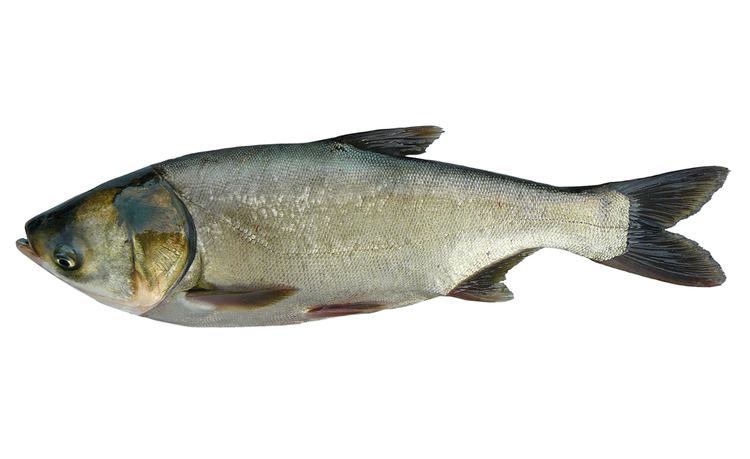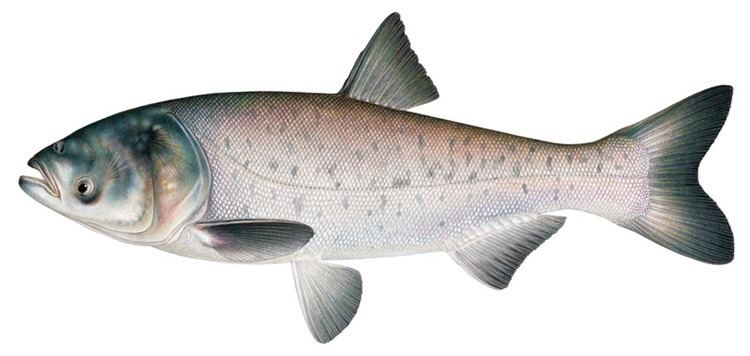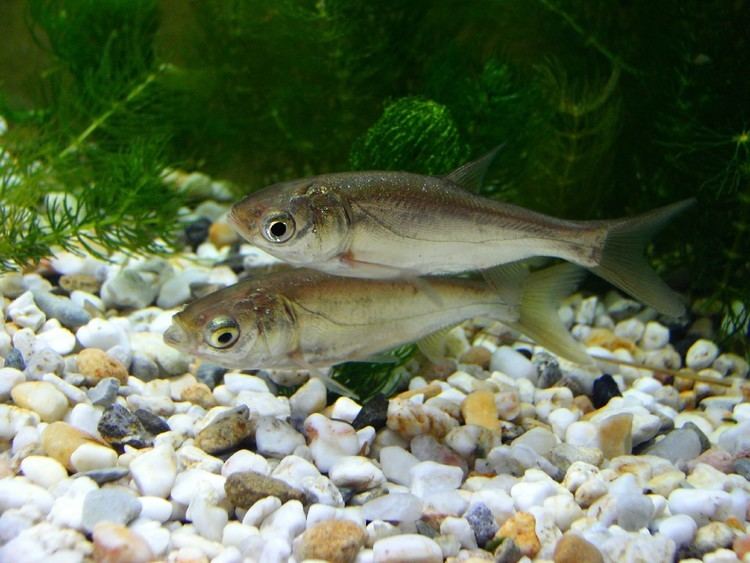Higher classification Hypophthalmichthys | Phylum Chordata Rank Species | |
Scientific name Hypophthalmichthys molitrix Similar Grass carp, Bighead carp, Hypophthalmichthys, Common carp, Black carp | ||
Fishing for asian carp how to catch bighead carp cooking silver carp
The silver carp (Hypophthalmichthys molitrix) is a species of freshwater cyprinid fish, a variety of Asian carp native to China and eastern Siberia. Although a threatened species in its natural habitat, it has long been cultivated in China. By weight more silver carp are produced worldwide in aquaculture than any other species of fish except for the grass carp. Silver carp are usually farmed in polyculture with other Asian carp, or sometimes with catla or other fish species.
Contents
- Fishing for asian carp how to catch bighead carp cooking silver carp
- Flying silver carp on wabash river in indiana
- Diet
- Ecology and conservation
- Sport fishing
- Related species
- In North America
- References

The species has also been introduced to, or spread by connected waterways, into at least 88 countries around the world. The reason for importation was generally for use in aquaculture, but enhancement of wild fisheries and water quality control have also been intended on occasion. In some of these places the species is now considered an invasive species.

The silver carp reaches an average length of 60–100 cm (24–39 in) with a maximum length of 140 cm (55 in) and weight of 45 kg (99 lb).

Flying silver carp on wabash river in indiana
Diet
The silver carp is a filter feeder and possesses a specialized feeding apparatus capable of filtering particles as small as 4 µm. The gill rakers are fused into a sponge-like filter, and an epibranchial organ secretes mucus which assists in trapping small particles. A strong buccal pump forces water through this filter. Silver carp, like all Hypophthalmichthys species, have no stomachs; they are thought to feed more or less constantly, largely on phytoplankton. They also consume zooplankton and detritus. Because of their plankton-feeding habits, they are thought to compete with native planktivorous fishes, which in North America include paddlefish (Polyodon spathula), gizzard shad (Dorosoma cepedianum), and young fish of almost all species.

Because they feed on plankton, they are sometimes successfully used for controlling water quality, especially in the control of noxious blue-green algae (cyanobacteria). Certain species of blue-green algae, notably the often toxic Microcystis, can pass through the gut of silver carp unharmed, picking up nutrients in the process. Thus, in some cases, blue-green algae blooms have been exacerbated by silver carp. Microcystis has also been shown to produce more toxins in the presence of silver carp. These carp, which have natural defenses to their toxins, sometimes can contain enough algal toxins in their systems to become hazardous to eat.
Ecology and conservation

The silver carp in its natural range migrates upstream for spawning; eggs and larvae then drift downstream, and young fish hatch in the floodplain zone. Larvae and small juveniles feed on zooplankton, switching to phytoplankton once a certain size is reached. The species is somewhat sensitive to low oxygen conditions.
The species is currently classified as near threatened in it original range, as its habitat and reproductive behavior are impacted by construction of dams, pollution, and overfishing. Population declines appear to have been particularly significant in the Chinese parts of its range.
Sport fishing
Silver carp are filter feeders, thus are difficult to catch on typical hook-and-line gear. Special methods have been developed for these fish, the most important being the "suspension method", usually consisting of a large dough ball that disintegrates slowly, surrounded by a nest of tiny hooks embedded in the bait. The entire apparatus is suspended below a large bobber. The fish feed on the small particles released from the dough ball and bump against the dough ball, with the intention of breaking off more small particles that can be filtered from the water, eventually becoming hooked on the tiny hooks.
In some areas, it is also legal to use "snagging gear", in which large, weighted treble hooks are jerked through the water, to snag the fish. In the United States, silver carp are also popular targets for bowfishermen; they are shot both in the water and in the air. In the latter case, boats are used to scare the fish and entice them to jump, and the fish are shot when they jump.
Related species
Two other species are in the genus Hypophthalmichthys, the bighead carp (H. nobilis) and the largescale silver carp (H. harmandi). The genus name Aristichthys has also sometimes been used for bighead carp, but is deprecated. The bighead carp differs from the silver carp in its behavior (it does not leap from the water when startled) and also in its diet. Bighead carp are also filter feeders, but they filter larger particles than silver carp and in general consume a greater proportion of zooplankton in their diets than silver carp, which consume more phytoplankton. In at least some parts of the United States, bighead and silver carp hybridize in the wild and produce fertile offspring.
The largescale silver carp is closely related to the silver carp, but its native range is to the south of that of the silver carp, mostly within Vietnam. Unlike bighead and silver carp, largescale silver carp have not been widely introduced around the world for use in aquaculture, although at least one introduction was made to some waters of the Soviet Union, where they hybridized with the introduced silver carp.
In North America
Silver carp were imported to North America in the 1970s to control algae growth in aquaculture and municipal wastewater treatment facilities, but escaped from captivity soon after their importation and are now considered a highly invasive species.
Silver carp, with the closely related bighead carp, often reach extremely high population densities, and are thought to have undesirable effects on the environment and native species. They have spread into the Mississippi, Illinois, Ohio, and Missouri Rivers and many of their tributaries in the United States and are abundant in the Mississippi River watershed from Louisiana to South Dakota and Illinois. Navigation dams seem to have slowed their advance up the Mississippi River, and until late November 2008, silver carp had not been captured north of central Iowa on the Mississippi. Dams that do not have navigation locks are complete barriers to upstream natural movement of silver carp, unless fishermen unintentionally assist this movement by the use of silver carp as bait.
The silver carp is sometimes called the flying carp for its tendency to leap from the water when startled; it can leap up to 10 ft (3.0 m) into the air. Boaters traveling in uncovered high-speed watercraft have been reported to be injured by running into the fish while at speed. A leaping silver carp broke the jaw of a teenager being pulled on an inner tube, and water skiing in areas where silver carp are present is extremely dangerous.
